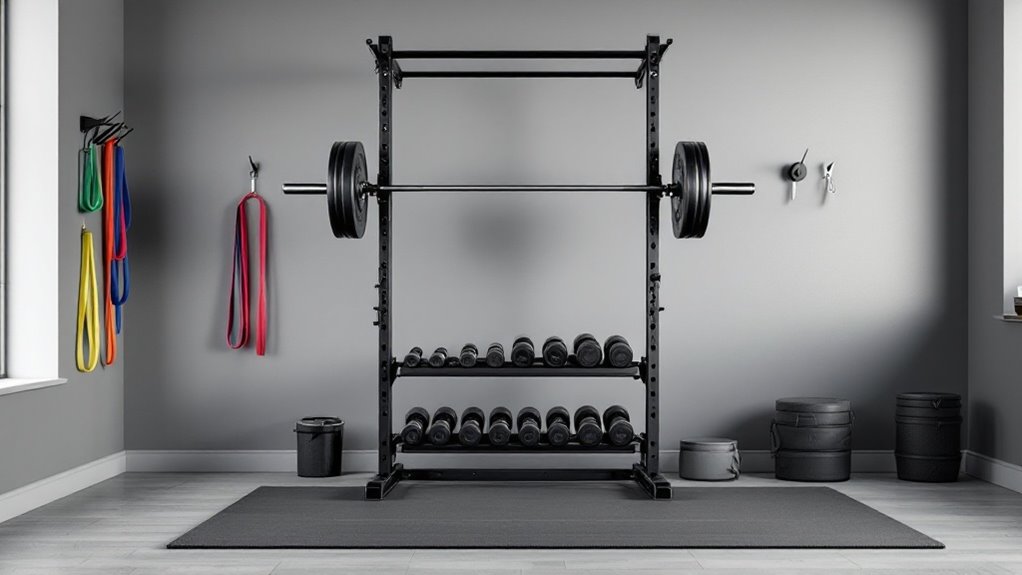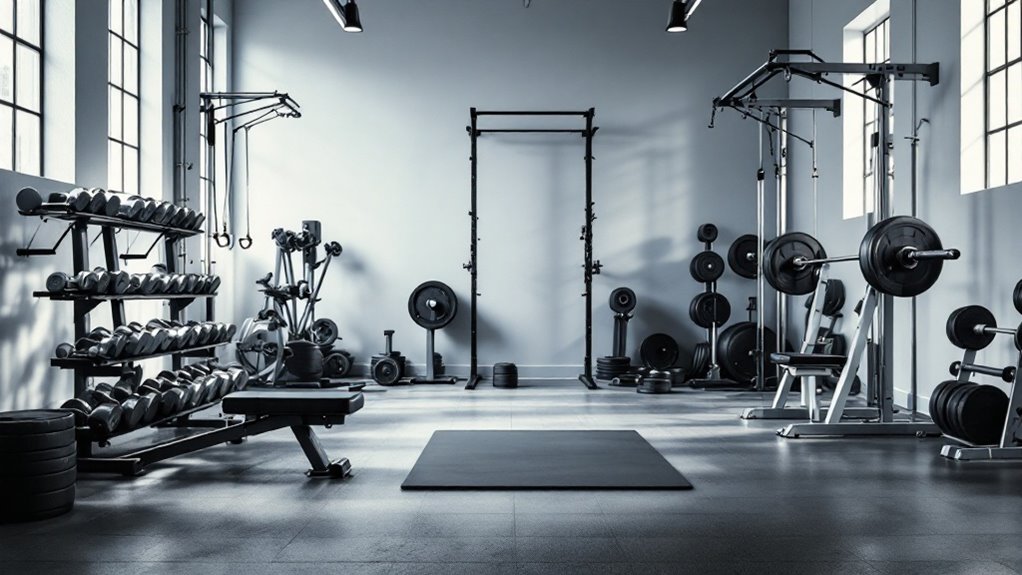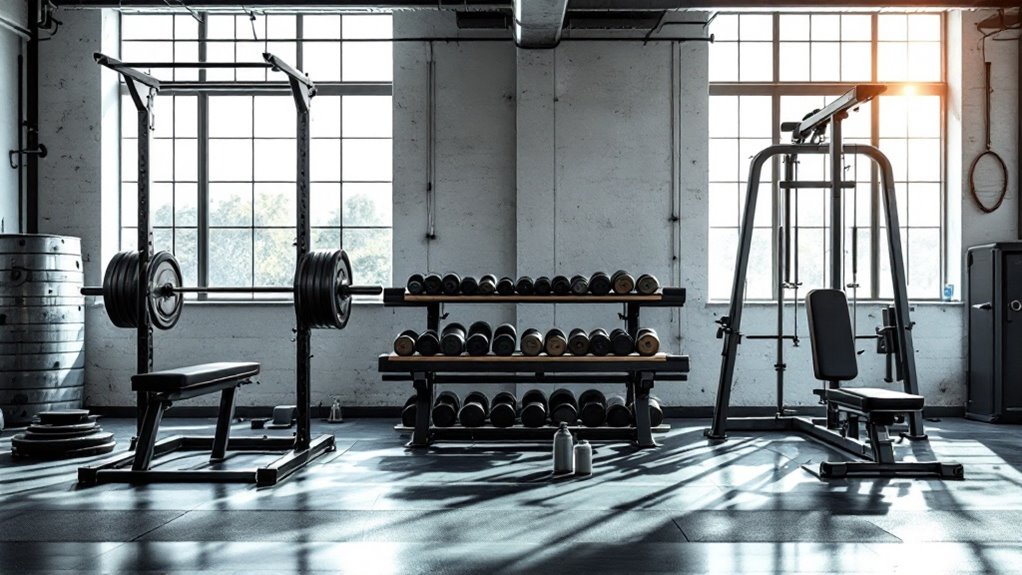Best Workout Splits

The most effective workout splits depend on individual fitness goals and experience levels. Beginners benefit from full-body workouts 2-3 times weekly to build foundational strength and proper form. Intermediate lifters can progress to upper/lower splits for improved recovery and muscle development. Advanced athletes often thrive with push-pull-legs routines, allowing specialized volume and ideal progression. Understanding each split's benefits reveals the path to achieving specific fitness objectives.
Key Takeaways
- Full-body workouts are ideal for beginners, targeting all major muscle groups 2-3 times weekly while allowing adequate recovery time.
- Upper/lower splits offer balanced training frequency for intermediate lifters, with 10-20 sets per muscle group weekly for optimal growth.
- Push-pull-legs splits provide targeted volume and specialized structure, making them suitable for advanced lifters seeking specific muscle adaptations.
- Training split selection should align with individual goals, experience level, and available time commitment for best results.
- Beginners should start with full-body workouts, intermediates can progress to upper/lower splits, and advanced lifters benefit from push-pull-legs routines.
Full-Body Training: The Perfect Starting Point

While many fitness enthusiasts chase advanced training splits, full-body workouts remain the gold standard for beginners entering the fitness world. These foundational routines efficiently target all major muscle groups in single sessions, making them ideal for those starting their fitness journey. Implementing 2-3 training days per week provides optimal recovery time between sessions.
Full-body training delivers maximum results with minimal gym time, perfect for busy individuals aiming to establish consistent workout habits. By incorporating compound movements like squats and push-ups, beginners develop functional strength that translates directly to daily activities. The cardiovascular fitness benefits of full-body workouts also contribute to improved heart health and endurance. Following proper rest periods between sets ensures optimal muscle recovery and growth potential.
The balanced approach prevents muscle imbalances while reducing excessive soreness, allowing for sustainable progress and faster recovery between workouts.
Upper/Lower Split: Maximizing Strength and Recovery

The upper/lower split stands as one of the most effective and scientifically-proven training approaches for intermediate lifters ready to advance beyond full-body routines.
This strategic division allows for ideal recovery while maximizing strength gains through focused training sessions. Training in this format supports sustainable weight loss when paired with proper nutrition. Most programs recommend 10-20 sets per week for optimal muscle development.
The split typically incorporates hypertrophy rep ranges of 8-12 repetitions per exercise for maximum muscle growth.
Research shows muscles trained twice weekly experience nearly double the hypertrophy compared to once-weekly training.
The split's 48-72 hour recovery window between sessions strikes the perfect balance for protein synthesis and muscle repair.
Benefits and Drawbacks of Popular Training Splits

Selecting a preferable training split stands as one of the most essential decisions in any lifter's journey toward their fitness goals.
Two prominent approaches illustrate the trade-offs lifters must consider. Full-body workouts excel in efficiency and accessibility, delivering thorough muscle involvement through compound movements while requiring minimal weekly sessions. The three-day workout split is particularly beneficial for beginners looking to establish proper form and build foundational strength. Research has demonstrated that exercise order impacts overall performance and strength development. Progressive overload principles are crucial for continuous improvement in any training program.
Full-body training maximizes workout efficiency through comprehensive compound movements, offering an accessible approach for lifters to achieve complete muscular engagement.
However, they demand strict recovery protocols and may limit advanced hypertrophy.
The Push-Pull-Legs split offers targeted volume and optimized recovery through its specialized structure.
This athletic-focused approach allows for customization while maintaining balanced frequency, making it particularly suitable for intermediate to advanced lifters seeking specific adaptations in strength and muscle development.
How to Choose the Right Split for Your Goals

Determining the ideal training split requires careful consideration of individual goals, experience level, and available time commitment.
For muscle gain, a push/pull/legs split enhances hypertrophy through focused volume training. Due to the growing research, experts recommend following nonlinear periodization to prevent plateau in training progress. Those pursuing strength should opt for powerlifting-style splits with heavy compound movements. Adequate recovery time between sessions allows muscles to repair and grow stronger.
Tracking your progress through progressive overload is essential for achieving consistent results in any split routine.
Fat loss goals are best served by full-body or upper/lower splits combined with cardio, while endurance seekers benefit from circuit-based training.
Beginners should start with 2-3 full-body sessions weekly to build foundational strength, while intermediate lifters can progress to 4-day splits as their recovery capacity improves.
Those addressing muscle imbalances can utilize specialized body part splits for targeted development.
Frequently Asked Questions
Can I Mix Different Workout Splits Within the Same Training Week?
Mixing different workout splits within a training week is effective when executed strategically.
Athletes can combine full-body sessions with targeted splits like push/pull/legs or upper/lower to optimize muscle growth and recovery.
The key lies in managing volume, avoiding overlapping muscle groups on consecutive days, and ensuring adequate rest periods.
This approach allows hitting major muscle groups 2-3 times weekly while preventing overtraining.
How Should I Adjust My Workout Split During Injury Recovery?
Studies show that 50% of athletes who rush back to full training intensity experience reinjury within 6 months.
During injury recovery, splits should be modified by reducing volume by 40-50%, switching to full-body or upper-lower splits for increased recovery time, and incorporating rehabilitation exercises.
Cross-training with low-impact activities helps maintain fitness while allowing injured areas to heal properly.
Do Different Splits Require Different Amounts of Protein and Calorie Intake?
Different workout splits don't fundamentally change protein and calorie requirements.
The body's needs remain primarily driven by overall training volume, goals, and recovery demands. Protein intake stays consistent at 30-40% of daily calories across splits to support muscle maintenance and growth.
Total calories may increase slightly with higher frequency splits due to increased energy expenditure, but the core macronutrient ratios stay relatively stable.
Should Workout Splits Change Based on the Season or Weather?
Research shows that workout performance can drop by up to 30% in extreme temperatures above 90°F or below 32°F.
Seasonal training adaptations are essential for ideal results. Training splits should correspond with environmental conditions – shorter, intense sessions during summer heat, longer strength-focused workouts in winter, and balanced routines during moderate seasons.
This approach enhances performance while preventing weather-related setbacks and maintaining consistent progress.
When Is the Best Time to Transition From One Split to Another?
The ideal time to shift between workout splits occurs during key trigger points: when progress plateaus for 2-3 weeks, recovery becomes consistently difficult, or lifestyle changes demand adjustment.
Athletes should monitor performance metrics, recovery quality, and schedule constraints.
Shifts work best during deload weeks or natural breaks in training cycles to minimize disruption and maintain momentum toward fitness goals.
Final Thoughts
Like Hercules choosing his labors, selecting the right workout split is a personal journey that shapes your fitness destiny. Whether embracing full-body workouts like the ancient Greek athletes, or adopting modern upper/lower splits reminiscent of golden-era bodybuilding, success lies in matching your routine to your goals, recovery capacity, and lifestyle. The path to physical excellence isn't one-size-fits-all – it's about finding your unique rhythm and staying committed to it.


